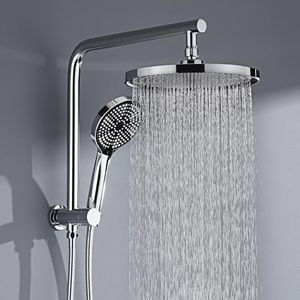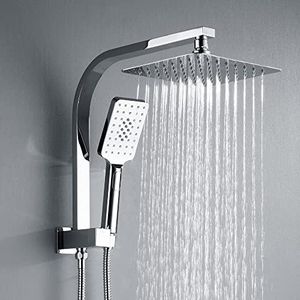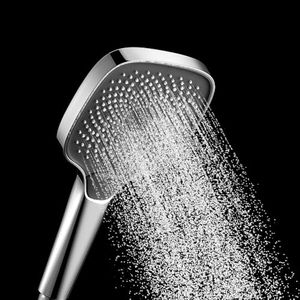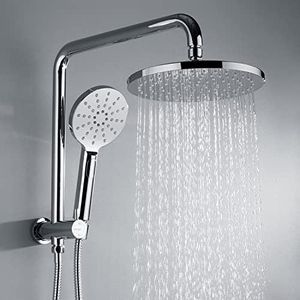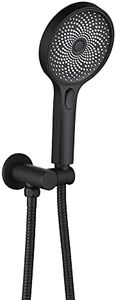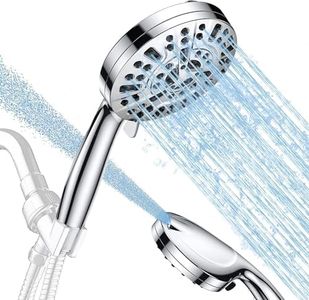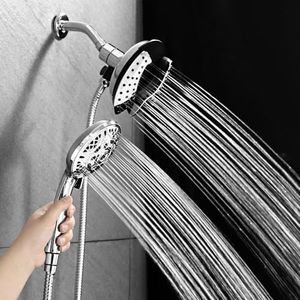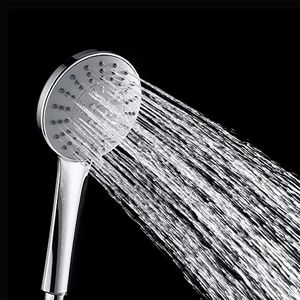We Use CookiesWe use cookies to enhance the security, performance,
functionality and for analytical and promotional activities. By continuing to browse this site you
are agreeing to our privacy policy
10 Best Hand Held Shower Head
From leading brands and best sellers available on the web.By clicking on a link to a third party's website, log data is shared with that third party.
Buying Guide for the Best Hand Held Shower Head
Choosing a hand-held shower head can greatly improve your shower experience, offering more flexibility and comfort than fixed options. The right one should suit your bathroom style, meet your needs for water pressure and coverage, and be easy to handle and install. Understanding a few key specifications will help you compare models and find one that fits best with your daily routine.Spray SettingsSpray settings refer to the different types of water flows a shower head can provide, such as gentle mist, concentrated massage, or a classic wide spray. This feature is important because it affects the feel of your shower—some people enjoy a strong jet to help relieve muscle tension, while others prefer a softer mist. Models range from single-spray (one type only) to multiple spray settings (usually between three and eight options). If you like variety or share the shower with others who have different preferences, more spray settings could be better. If your needs are simple, a basic single or dual spray setting will likely be enough.
Hose LengthThe hose length is the measurement of the flexible tube connecting the shower head to the water pipe. This matters because it determines how much reach you have, which is important for tasks like cleaning the shower, washing pets, or helping children bathe. Short hoses (around 4-5 feet) are compact, good for small showers, and limit reaching distance. Standard lengths (5-6 feet) offer comfortable flexibility for everyday use, while longer hoses (6-8 feet or more) provide maximum reach and convenience, especially in larger showers or for users who need extra accessibility. Consider your shower size and purpose—the bigger the area or the more varied your needs, the longer the hose you'll want.
Water Pressure CompatibilityWater pressure compatibility refers to how well the shower head performs with your home's water pressure. Some shower heads are made to work best with low pressure, others are good for high pressure, and some work well with both. This is important because a shower head that's not matched to your water pressure can lead to weak or uncomfortable showers. Check if your home has low, normal, or high water pressure (you can often ask a plumber or check your water company’s info). If pressure is low, look for models designed to boost or work efficiently with low pressure. If you have strong water pressure, almost any model will work, but make sure the flow isn't too intense for comfort.
Material and Build QualityMaterial and build quality describe what the shower head and hose are made of, such as plastic, metal, or a combination. This matters for durability, appearance, weight, and how easy it is to clean. Lightweight plastic models can be easier to handle and won’t rust, but may not last as long or look as high-end. Metal or stainless steel models are sturdier and feel more luxurious, but may be heavier. Choose lightweight materials for easy daily use or children, or sturdier builds if you value longevity and a premium look.
Ease of InstallationEase of installation means how simple it is to attach the shower head to your existing shower setup without special tools. Most hand-held shower heads are designed for easy, tool-free installation—just screw them on. Some models might require extra adapters or sealants. If you’re not handy or want to save effort, pick a model with clear instructions and basic installation needs. If you have a non-standard shower connection, check if any special parts will be required.
Maintenance FeaturesMaintenance features cover things like anti-clog nozzles, self-cleaning technology, or easy-to-wipe surfaces that prevent mineral build-up. This is important if you have hard water, since minerals can clog nozzles and reduce performance over time. If you want a hassle-free experience and less cleaning, look for features like silicone or rubber nozzles that can be wiped clean, or built-in filters that trap debris.
